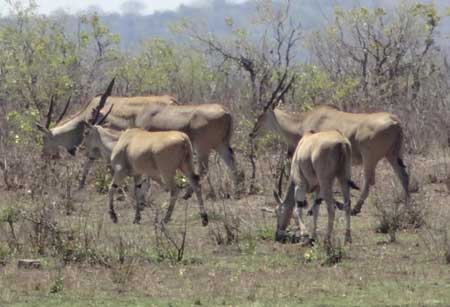NSHAWU MARSH

from Tinkers’ Kruger Park Map & Guide
Like the Malopenyana and the Mooiplaas Rivers, the Nshawu River flows into the Tsendze. Unlike them, however, it has its source in the Lebombo Mountains on the border between the Park and Mozambique and is therefore both longer and stronger. The road (S50) along the marsh, which lies some four kilometres to the east of the Mooiplaas waterhole, giving access to three different waterholes (Nos. 1, 2 & 3) and a small dam along its length, is approximately 15 km long.
The entire length of the Nshawu is marshy, but the broadest part of the marsh is to the north of Nshawu Dam.
This road is our favourite place in the Mopani area and we come to it with great anticipation. It is not always consistent though, and sightings are definitely better in the rainy season. The drought of 2016 dried up the sightings as much as it dried up the water! The only exception seemed to be the Tsessebe, zebra and buffalo.

January 2016

Same place but across the road in January 2017!

Nshawu Marsh to the north of Nshawu Dam in March
I have mentioned before that we have been extraordinarily fortunate in finding Tsessebe in the Park, for not only have we often seen them at the Mooiplaas Waterhole, but we have also seen them several times south of Mopani on the main road (H1-6) and north of Shingwedzi on the H1-7 (and surprisingly, we once saw two near Pretorius Kop, way down south on the H1-1!). Without a doubt, however, it is the Nshawu Marsh which has given us the most frequent sightings.

On the marsh

Coming off the marsh

Nshawu Dam

The best sighting we ever had was one day in May when we saw a herd of them coming from the Nshawu Dam, a small, natural dam which is actually part of the marsh.





Just six months before, in November, we had our most productive day ever with regard to antelope. Not only did we see Tsessebe at Mooiplaas, but soon after turning onto the marsh road we had our first ever sighting of Reedbuck. They were just off the side of the road - so close we could almost have touched them!


And then, not even half an hour later, across the marsh, we saw a large herd of eland!


The distance and the heat haze resulted in blurred photographs,
but, no matter! Eland! Wow!
In fact, double wow!!


The marsh has its own resident herd of buffalo and they usually provide opportunities for portrait shots. I find it so fascinating that, unlike most Park animals, they can quite easily be distinguished from one another. Not only are their horns different in shape and length, but they have very distinctive facial markings and together these produce interesting ‘facial expressions’.

Sceptical Sue

Sleepy Sam

Puzzled Polly

We have yet to come to Nshawu and not see elephants, both on and off the marsh.


Eyelashes like a broom!

Mr Waterbuck with his magnificent horns
As their name suggests, Waterbuck are very water dependant, so you can be almost sure of seeing them near the marsh. Dominant bulls stay faithful to their territories while young bulls form bachelor groups. Cows and calves form loosely associated herds. The social structures are fluid. No control freaks amongst the cows!

One of his wives

Junior peacefully resting

Junior hopping up in indignation
Giraffe are also often on the marsh road where the vegetation is suitable. The most unusual sighting we had was a good way off opposite the marsh, where they looked for all the world like a row of mechanical cranes!


Korhaan, spurfowl and Crested Francolins are always around and in the summer months you usually find them on the roads with their broods of chicks, which are particularly cute when still tiny. Photographing them is another story though, as they scuttle into the grass growing at the side of the road as fast as they can. One morning I struck it very lucky and got a shot of a Crested Francolin chick through the windscreen.

Crested Francolin chick

Black-bellied Korhaan.

Swainson’s Spurfowl

What the above altercation was about was not clear. The adult was very aggressive towards the half grown chick and chased it off.

A convention of White Storks on the other side of the marsh. These are summer visitors.

One of my favourite birds is the Lilac-breasted Roller, which is a permanent resident in the Park, so you can be sure to see them no matter when you visit. The one here was on the opposite side of the marsh road. This was a particularly good sighting as both light and position were perfect to pick up the contrasting colours. We have been informed that the feathers of this beautiful bird have a range of seventeen different colours!
Before we leave the Nshawu Marsh, there are two other marsh photos I want to share with you - simply because they are beautiful!

A creche of Impala lambs along the marsh road in January 2017 when the Park was a flowering paradise.

Zebra love the marsh in all seasons.